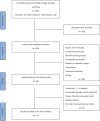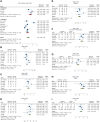Acute Kidney Injury in Adult Patients With Hepatocellular Carcinoma After TACE or Hepatectomy Treatment
- PMID: 35686095
- PMCID: PMC9172446
- DOI: 10.3389/fonc.2022.627895
Acute Kidney Injury in Adult Patients With Hepatocellular Carcinoma After TACE or Hepatectomy Treatment
Abstract
Background: Acute kidney injury (AKI) is one of the most common complications in patients with cancer, yet the specific reasons, mechanisms, and the influence of AKI are not clear in hepatocellular carcinoma (HCC) after treatment. This meta-analysis aimed to find out the risk factors and the impact on mortality of AKI in adult patients with HCC after treatment using available published data.
Methods: We performed a systemic literature search using PubMed, Web of Science, and Embase, encompassing publications up until November 30, 2021 (inclusive), with 17 cohort studies involving 11,865 patients that fulfilled the prespecified criteria for inclusion in the meta-analysis. The number of AKI/non-AKI patients identified by risk factors, the number of AKI/non-AKI-related deaths, the incidence rates, the mortality rates, and the irreversible rates of AKI were derived and analyzed using STATA.
Results: Age, diabetes mellitus (DM), and the number of transarterial chemoembolization (TACE) sessions are risk factors for AKI in patients with HCC after TACE. On the other hand, male gender, age, DM, major resection of the liver, and operation-related transfusion are risk factors for AKI in patients with HCC after hepatectomy. The risk of mortality in those with renal failure due to AKI was up to 4.74 times higher than in those without AKI in a short-term observation period after TACE treatment.
Conclusions: Attention should be paid to the risk of AKI in HCC patients with DM. The occurrence of AKI during TACE treatment is especially dangerous and should be considered a strong red flag, obviously with regard to the extremely high risk of death in a short period. Furthermore, studies are needed to detect more associations of AKI in patients with HCC.
Keywords: AKI; HCC; hepatocellular carcinoma; mortality; risk.
Copyright © 2022 Mou, Guan and Chen.
Conflict of interest statement
The authors declare that the research was conducted in the absence of any commercial or financial relationships that could be construed as a potential conflict of interest.
Figures




References
-
- NCCN. Clinical Practice Guidelines in Oncology Version 5.2021. Available at: https://www.nccn.org/guidelines/category_1.
Publication types
LinkOut - more resources
Full Text Sources
Miscellaneous

